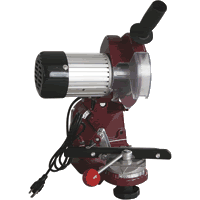duffontap
ArboristSite Member
Ok, when I first got interested in chainsaw milling, I thought, 'I'll get 5 loops of chain and a $150 grinder and I'll never need to drop my chains off at the saw shop again.' Well, I realized after a couple weeks of thinking that waiting for the money to buy a powered bench-mounted grinder and 5 loops of chain ($100) would mean never being able to afford to start.  So, I went the opposite direction and bought 1 loop of chain telling myself to 'suck it up and hand file it.'
So, I went the opposite direction and bought 1 loop of chain telling myself to 'suck it up and hand file it.'
I'm careful with what I cut so I'm not rocking my chain or milling through nails and chipping up the teeth. The first 4-5 times my chain started acting dull, I carefully made about 3-5 passes with a file on each tooth and it would cut like butter again. I would say, 'why would anyone bother to buy an expensive grinder?' Well, the last two mornings I milled, I was milling some pretty dirty logs and even though my teeth still looked undamaged, I wasn't getting very good results by filing the chain.
After 8 hand-sharpenings, I took the chain to the saw shop for a professional grind. They did not inspire any of my confidence when the guy at the counter said, 'hey Bubba, can we sharpen ripping chain?' Bubba further destroyed my faith in them by looking at the chain and saying, 'looks like a normal grind to me.' I explained to him 5 times in a row with increasing simplicity and conviction that IT WAS different and I wouldn't be pleased if he put anything other than the factory grind on it. He explained to me 6 times that he couldn't see the difference between my chain and a normal cross-cut chain. I'm paying them $8 to do what they don't know how to do.
All that said, I need a home sharpening system that can bring my chains back to perfect--perfect--after a few touch-up filings on the job. I don't have a huge budget here so I was thinking about the powered version of the Granberg file-n-joint or the cheapest bench-mounted grinder I can get from Bailey's ($99).
I would be very interested in any advice you guys have to offer. What works?
J. D.
I'm careful with what I cut so I'm not rocking my chain or milling through nails and chipping up the teeth. The first 4-5 times my chain started acting dull, I carefully made about 3-5 passes with a file on each tooth and it would cut like butter again. I would say, 'why would anyone bother to buy an expensive grinder?' Well, the last two mornings I milled, I was milling some pretty dirty logs and even though my teeth still looked undamaged, I wasn't getting very good results by filing the chain.
After 8 hand-sharpenings, I took the chain to the saw shop for a professional grind. They did not inspire any of my confidence when the guy at the counter said, 'hey Bubba, can we sharpen ripping chain?' Bubba further destroyed my faith in them by looking at the chain and saying, 'looks like a normal grind to me.' I explained to him 5 times in a row with increasing simplicity and conviction that IT WAS different and I wouldn't be pleased if he put anything other than the factory grind on it. He explained to me 6 times that he couldn't see the difference between my chain and a normal cross-cut chain. I'm paying them $8 to do what they don't know how to do.
All that said, I need a home sharpening system that can bring my chains back to perfect--perfect--after a few touch-up filings on the job. I don't have a huge budget here so I was thinking about the powered version of the Granberg file-n-joint or the cheapest bench-mounted grinder I can get from Bailey's ($99).
I would be very interested in any advice you guys have to offer. What works?
J. D.






